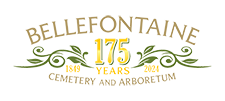At Bellefontaine Cemetery, many of our wild friends find that our serene atmosphere – with it’s large, old-growth trees, dense shrub and perennial plantings – makes for an excellent spot to settle down and raise a family.

From mammals to insects, the cemetery fosters an environment very conducive to the nesting habits of various animals. When maintaining the landscape, we try to encourage such habitat by practicing proper horticultural technique with regards to wildlife. For instance, Bellefontaine staff will leave stands of dead perennial leaves and stems, since many small birds and mammals will hide their homes in the thick, dense, dead material – not to mention the number of insects that find sanctuary here.

In fact, some of our native bees will use the pithy stems left behind by perennial hibiscus, milkweed, and aster to burrow inside and lay eggs. Many of our amphibian and reptilian friends need these areas of leaf and twig debris to hide from predators. In addition to these spots lending themselves to new home-sites for our critter friends, birds will also use this leftover material to build their nests in trees or on the ground. Baltimore Orioles build their nests out of a number of found items, often consisting of grasses, twigs, leaves – and sometimes – discarded leaf-trimmer string! Red-Tail Hawks build up to four large nests constructed from larger sticks and leaves, eventually choosing the nest best located for the success of their young.

Mammals, amphibians, reptiles and insects also use dead plant litter to pad burrows and nests. Squirrels build large nests that appear to be clusters of oak-leaves high in the branches of trees. Leaf-cutter bees will use pieces of leaves to cover the entrance of their nests. Red Foxes use grasses to line their dens for warmth and comfort.

Other animals will utilize existing features to build nests, like dead and/or hollow trees. The Great-Horned Owl will find large cavities in older trees and line these with leaf litter, furs and feathers from prey. Raccoons and flying squirrels often find a haven in tree cavities. Feral honey bee colonies will establish their hives inside of trees that offer a hollow with a small entrance, often left behind from a previous cavity-nesting animal (woodpeckers make great entrance holes for honey bee hives!)


Despite the plant being dead or dormant, the remnants can still provide a setting for life. At Bellefontaine Cemetery, we pride ourselves in being an oasis of natural landscape in the midst of St. Louis’ urban sprawl. With that in mind, it is our responsibility to sometimes disregard common garden practices to retain an environment conducive to a large number of wild animals.

Post a comment